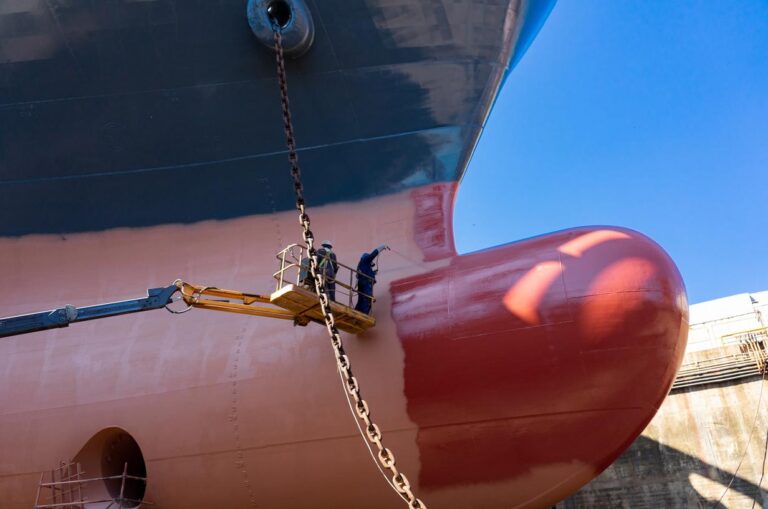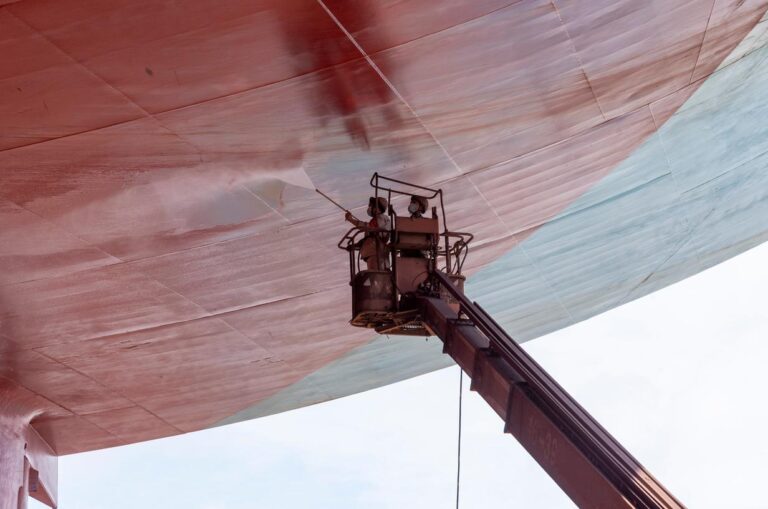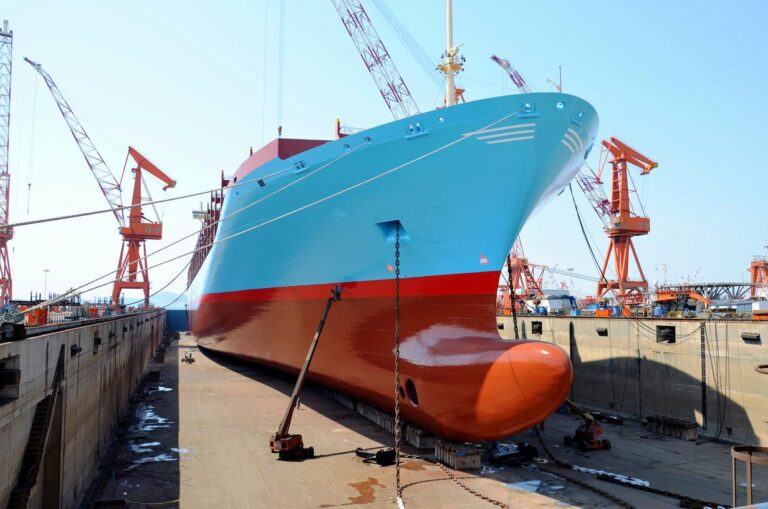Marine Sandblasting and Painting: Ships, Naval Vessels, Dockyards
Markley’s Precision Company (MPC) stands as a leading provider of marine sandblasting and painting services, catering to Cargo Ships, Naval Vessels, and Dockyard Structures across Ohio and nationwide. With our extensive experience and unwavering dedication to excellence, we consistently deliver superior results that align with the highest industry benchmarks.
Our proficient team employs cutting-edge equipment and methodologies to achieve optimal surface preparation and coating application across all types of marine vessels.
We specialize in advanced marine sandblasting techniques that meticulously remove old paint, barnacles, rust, and corrosion from the surfaces of cargo ships, naval vessels, and dockyard machinery, ensuring a pristine and smooth base for the application of new paint.
The SSPC (Society for Protective Coatings) sets forth a comprehensive range of standards and specifications for surface preparation methods, including sandblasting. These standards are designed to guarantee the correct application of coatings and provide robust corrosion protection in maritime and dockyard settings. While the specific standard may vary based on the cargo ship type and dockyard requirements, we adhere to SSPC guidelines to ensure our sandblasting specifications meet or exceed industry expectations.
Send Your Request And Get A Free Quote
























Why Choose Us?
Diverse Coating & Painting Arsenal
Versatile Project Capability
Quality Finishes and Durability
Accident Free Safety Record
Best-In-Class Warranties
Zero Downtime Process
Safety & Environmental Commitment
Nationwide Service Coverage
Why You Should Paint Your Marine Vessels with MPC
Extended Lifespan
Cost Savings
Improved Performance
Aesthetic Enhancement
Eco-Friendly Process
Dust-Free Method
Versatile Service Locations
Our Marine Vessel & Dockyard Structures Painting Process
Proper surface preparation of the vessel is crucial for the long-lasting adhesion of paint. Our team expertly prepares surfaces through abrasive blasting, including sandblasting, to achieve the optimal surface profile for coating application.
- SSPC-SP 5 / NACE No. 1: White Metal Blast Cleaning
This is the highest level of surface preparation, suitable for immersion service or high-performance coating systems. - SSPC-SP 6 / NACE No. 3: Commercial Blast Cleaning
Suitable for areas where appearance is not critical, but tight adhesion of rust, mill scale, and old coatings is permitted. - SSPC-SP 10 / NACE No. 2: Near-White Blast Cleaning
This standard is often specified for areas where a white metal blast is not feasible or necessary, but a higher level of cleanliness is required.
We offer professional painting services using high-quality, marine-grade coatings designed to withstand harsh marine environments. Our expert painters ensure precise application and a flawless finish, enhancing the durability and appearance of your vessels and equipment.
We specialize in applying protective coatings that offer superior corrosion resistance, UV protection, and color retention.
Our comprehensive coating solutions help extend the service life of cargo ships, naval vessels, and dockyard structures and machinery, reducing maintenance costs and downtime.
- Epoxy Coatings: Known for their excellent adhesion and corrosion resistance, these coatings are often used in areas with high exposure to seawater and salt spray.
- Zinc-based Coatings: Zinc-rich primers provide galvanic protection and are applied in areas where corrosion is a significant concern.
- Copper-Based Coatings: Anti-fouling coatings containing copper compounds effectively prevent the growth of marine organisms on the hull, reducing drag and improving fuel efficiency.
- Polyurethane Coatings: Polyurethane topcoats offer excellent UV resistance, color retention, and gloss, making them suitable for exposed surfaces and superstructures.
At MPC, we are committed to delivering exceptional results on every project. We adhere to strict quality control measures throughout the sandblasting and painting process to ensure compliance with industry standards and customer specifications.
Marine Vessel Surface Restoration - Your Curious Queries
The answer depends on a couple variables; The first question we need to ask, is what does “restore” look like to you? If it means trying to restore by removing dirt, salts, stains, surface level contaminants, then this process could be different entirely. If restore to you means you want to remove the old paint, sealer, varnish, etc. and change the look of the boat entirely then we need to dive a little further…
Secondly, what does “best” mean to you? If best means the best quality and quickest turnaround, then your best option would be to have a professional company clean and prepare the substrate (surface) via an SSPC SP1 solvent clean (pressure wash & degrease) to remove surface contaminants and then sandblast or wetblast (dustless blast) the surface with the proper blast media and blast pressure. If the best way means the most affordable way (for the DIY’er, consider what your time is worth in this equation), then it would likely involve a DA sander, with multiple passess of ascending sandpaper grits to the spec’d sandpaper grit recommended for whatever coating/sealer/etc you choose to apply.
If best quality and quickest turnaround sound like the best way to fit your needs, then we recommend taking it to a professional that is knowledgeable and experienced with restoring boat surfaces. They should be able to identify the vessel’s “substrate”, or in layman’s terms, what material the vessel is made out of. In our experience, the best way and sometimes the most economical way is to sandblast/wetblast/dustless blast the boat substrate. By identifying the substrate, a quality knowledgeable sandblasting company would use that information to be able to determine what blast media to use, how much blast pressure, and their nozzle type to give you a quality prepped surface. For marine vessels, typical substrates are: fiberglass, aluminum, steel, wood (typically oak, pine, larch, or cedar), plastic, and carbon fiber. Once we identify the substrate of the vessel, we can proceed with prepping.
The best way to do a thorough job would involve removing the motor, all lights, wiring, hand railing, trim pieces, and anything else that you’re not looking to get damaged or prepped during the sandblasting process. Once removed, if handling the prep in the field, we talk with the client about how to handle dust, mess, and set up potential containment around the vessel depending on what is decided. After containment questions are handled, then the company would proceed with prepping the surfaces the customer is looking to restore, again starting with degreasing the surfaces then blasting with the proper blast pressure, blast media, and blast nozzle.
Coatings and sealants vary based on boat substrate and we can’t speak for most consumer based watercrafts in terms of how to apply finishes, for a commercial vessel this typically involves applying marine grade zinc rich primer, and several coats of marine grade epoxy.
DIY surface restoration of a marine vessel can achieve somewhat professional results, but it requires the right tools, materials, and a significant amount of skill and patience. Professionals have access to high-quality equipment and materials that might not be readily available to DIY enthusiasts, and they bring expertise that ensures a high-quality finish.
The frequency of vessel/ship surface restoration depends on factors like the boat’s exposure to harsh environmental conditions, the type of material the boat is made out of, and the quality of previous restorations. Generally, a thorough restoration might be needed every few years, but regular maintenance can extend this period.
If you use your boat in a lake, your boat’s surface might need more frequent TLC. Algae and floating debris can leave scratches and dullness, diminishing your vessel’s sheen.
Here are some general guidelines:
- Fiberglass boats: Every 10 years
- Aluminum boats: Every 5-10 years
- Wooden boats: Every 3-5 years
However remember to inspect your boat yearly!
Safety precautions during ship or dockyard structures’ surface restoration include wearing protective gear like safety glasses, respirators, gloves, goggles, and masks. It’s also important to work in a well-ventilated area and to follow all safety instructions for any blasting media or equipment used.
At Markley’s Precision we ensure eco-friendly, biodegradable, and silica-free methods, reducing environmental impact and health risks.
Our service requires the vessel to be drydocked, or staged on blocks or jacks on land.
Restoring the surface of a boat while it’s in the water is not typically recommended due to the difficulty in controlling the work environment and potential environmental concerns. It’s usually best to perform such work on land, where the boat can be properly supported and the work area controlled.
The duration of a typical ship surface restoration process can vary widely depending on the size of the boat, substrate of the boat (surface material), coating thickness, and the extent of the restoration required. Small projects might take a few days, while larger, more involved restorations could take several weeks.
For example:
- Restoring the hull bottom of a 40-foot fiberglass boat with an average coating thickness typically requires a full 10-hour day.
- A comprehensive restoration of both the hull and deck, including blast media containment and cleanup, for a 40-foot boat with a similar coating thickness, can take approximately 50 hours.
Sanding the vessel’s surface before applying a new finish is generally necessary to ensure that the new finish adheres properly and looks its best. Sanding removes the old finish, smooths out imperfections, and provides a good surface for the new finish to bond to.
At Markley’s Precision we use dustless blasting which eliminates the need for manual sanding, as it effectively and safely removes old finishes and prepares the surface for painting.
Maintaining the restored surface of a vessel involves regular cleaning, periodic waxing or polishing, and prompt attention to any chips or damage. It’s also important to protect the boat/ship from excessive sun exposure and harsh environmental conditions as much as possible.
Techniques like dustless blasting can remove the faded and oxidized layer, potentially revealing the original color beneath. This should be followed by applying a new layer of paint or gelcoat. The process requires precision and care to avoid damaging the underlying surface and to ensure a uniform and vibrant finish.

